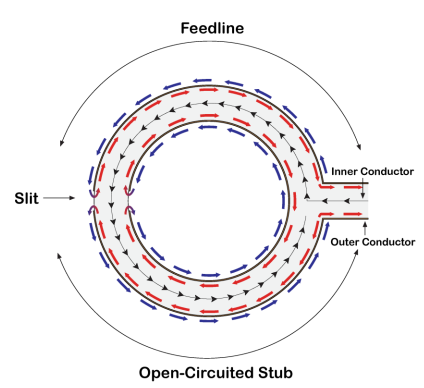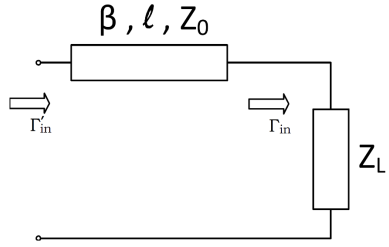Shielded-Loop Resonators
Contents
Shielded-Loop Resonators#
Topics#
Measurements of isolated (uncoupled) shielded-loop resonators
De-embedding the feedline
Modeling the resonator as an RLC circuit
Useful Equations#
Magnetically-Coupled Resonators#

Fig. 35 Schematic of Magnetically-Coupled Resonators#
Shielded-Loop Model#

Fig. 36 Shielded-Loop Resonator as Open-Circuited Stub#

Fig. 37 Open-Circuited Stub Completes Resonant Circuit#
Loop capacitance for open-circuited transmission line stub
\(C'\) is the per-unit-length capacitance of the tranmission line
Line parameters
\(\mu\) is the permeability of the surrounding medium
\(r\) is the radius of the loop
\(a_0\) is the cross-sectional radius of the loop; defined where rectangular cross-section wire and circular cross-section wire are approximately equal
\(d\) is the width of the rectangular wire
Resonant Frequency
Given shielded-loop parameters
Dielectric Properties |
|
|---|---|
Material |
Rogers RT/Duroid 5880 |
Relative Permitivity |
\(\epsilon_r = 2.2\) |
Loss Tangent |
\(\tan \delta = 0.009\) |
Conductor Properties |
|
|---|---|
Material |
copper |
Conductivity |
5.8E7 Siemens |
Thickness |
70 \(\mu\)m |
Geometry |
|
|---|---|
Radii |
5cm and 9cm |
Cross-sectional width |
\(d = 15\) mm |
Cross-sectional thickness |
\(3.32\) mm |
Stripline Tranmission Line |
|
|---|---|
Characteristic impedance |
\(Z_0 = 50\Omega\) |
De-embedding the Feedline#

Fig. 38 Effect of Transmission Line on Reflection Coefficient#
The insertion of a transmission line with characteristic impedance \(Z_0\) will change the phase of the load input reflection coefficient. Thus, the phase of \(\Gamma_{in}'\) should be increased by 2𝛽𝑙 to find the reflection coefficient of the RLC portion of the loop (\(\Gamma_{in}\)). Note \(\beta\) is frequency dependent so each frequency point must be adjusted by a different phase value.
De-embedding is the process of removing feedline effects.
Characterize the Resonator as an RLC Circuit#
E5063A ENA Vector Network Analyzer
Measurements
Loop |
Resonant Frequency |
Reflection Coefficient \(\Gamma_{in}'(f_0)\) |
Phase \(\phi\) |
|---|---|---|---|
5 cm loop |
\(f_0 = 85.7\) MHz |
||
9 cm loop |
\(f_0 = 47.4\) MHz |
Calculate: Electrical Length
Loop |
\(\beta l\) |
|---|---|
5 cm loop |
|
9 cm loop |
Finding R
At resonance, the input impedance \(Z_{in}\) is purely real. \(Z_{in} = R_{in} < Z_0.\) Note the input reflection coefficient is purely real and negative.
Additionally, if the feedline is lossless, then \(|\Gamma_{in}'| = \Gamma_{in}|\).
Finding L and C
To find \(L\) and \(C\), we need measurements at two distinct frequencies.
Measurements: Reflection Coefficient
Loop |
\(\Gamma_{a}'\) |
\(\Gamma_{b}'\) |
|---|---|---|
5 cm loop |
||
9 cm loop |
Calculate: Electric Length
Loop |
\(\beta_a l\) |
\(\beta_b l\) |
|---|---|---|
5 cm loop |
||
9 cm loop |
Using the de-embedded input reflection coefficients, the following is defined
Solving these relations simultaneously results in expressions for \(L\) and \(C\).
Q Factor
Summary#
\(R \ (\Omega)\) |
\(L \ (nH)\) |
\(C \ (pF)\) |
\(Q\) |
|
|---|---|---|---|---|
5 cm loop |
||||
9 cm loop |
